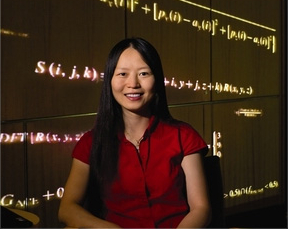ISCB-Asia/SCCG 2012 Keynote Address |
 |
ISCB-Asia/SCCG 2012 Keynote Address |
 |
We identified highly enriched sequence motifs in most data sets, revealing new motifs and validating known ones. The motif sites (TF binding sites) are highly conserved evolutionarily and show distinct footprints upon DNase I digestion. We frequently detected secondary motifs in addition to the canonical motifs of the TFs, indicating tethered binding and cobinding between multiple TFs. We observed significant position and orientation preferences between many cobinding TFs. Genes specifically expressed in a cell line are often associated with a greater occurrence of nearby TF binding in that cell line. We observed cell-line-specific secondary motifs that mediate the binding of the histone deacetylase HDAC2 and the enhancer-binding protein EP300.
TF binding sites are located in GC-rich, nucleosome-depleted, and DNase I sensitive regions, flanked by well-positioned nucleosomes, and many of these features show cell type specificity. The GC-richness may be beneficial for regulating TF binding because, when unoccupied by a TF, these regions are occupied by nucleosomes in vivo.
We present the results of our analysis in a TF-centric web repository Factorbook and will continually update this repository as more ENCODE data are generated.
Zhiping Weng graduated from the University of Science and Technology of China in 1992 with B.S. in Electrical Engineering. In 1993, she entered the graduate program in Biomedical Engineering at Boston University, and received her Ph.D. in 1997. The focus of her thesis research was in computational biology, specifically on calculating binding free energies of protein-protein interactions. In January 1997 Dr. Weng was appointed Instructor of Biomedical Engineering at Boston University. In that capacity she taught and conducted research, and had primary responsibility for the development of the Bioinformatics program and the core curriculum in Bioinformatics. In January 1999 the Biomedical Engineering Department at Boston University decided to grow in the area of Bioinformatics. After a national search, the department appointed Dr. Weng a tenure-track assistant professor. In September 2003, Dr. Weng was promoted to Associate Professor with tenure. Until December 2007, Dr. Weng's research had been focused on developing computational methods to obtain a predictive understanding of transcriptional regulation and protein-protein interaction. She had published 90 articles, including 75 peer-reviewed journal articles.
On 1 January 2008, Dr. Weng moved to University of Massachusetts Medical School to build and direct a new Program in Bioinformatics and Integrative Biology. She is a full professor, with tenure in Department of Biochemistry and Molecular Pharmacology. She is on the forefront of research in gene regulation, protein docking (developer of the well known tool ZDOCK) and small silencing RNAs. Recently, as part of the ENCODE consortium, she has lead seminal efforts to understand how transcription factors work together to regulate gene expression and what role epigenenetics plays in this process.